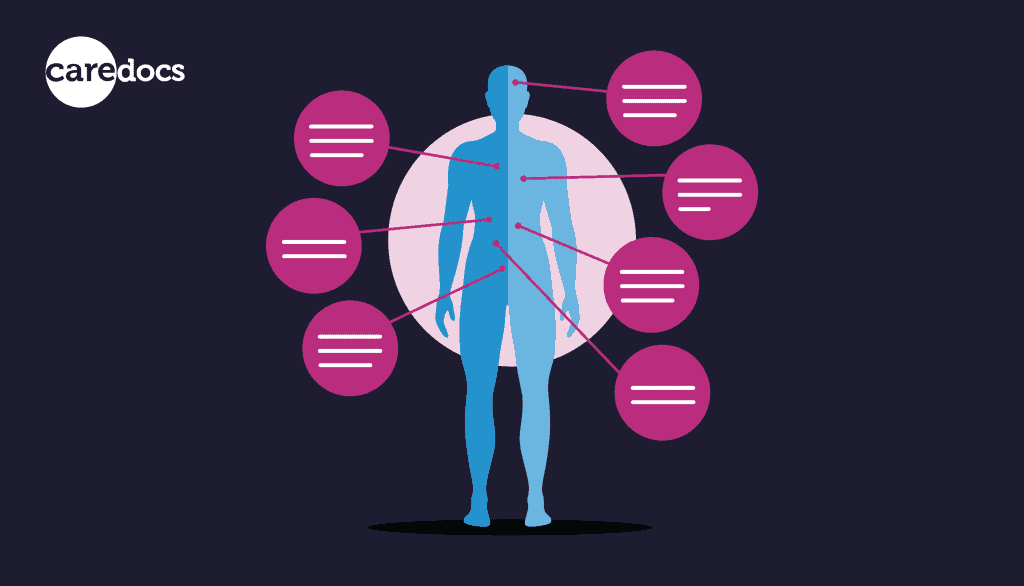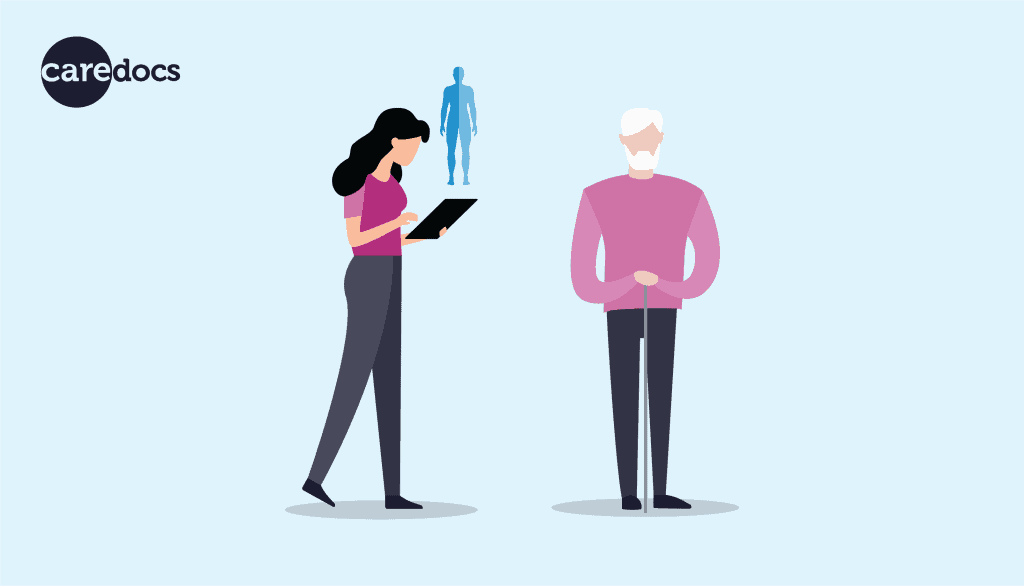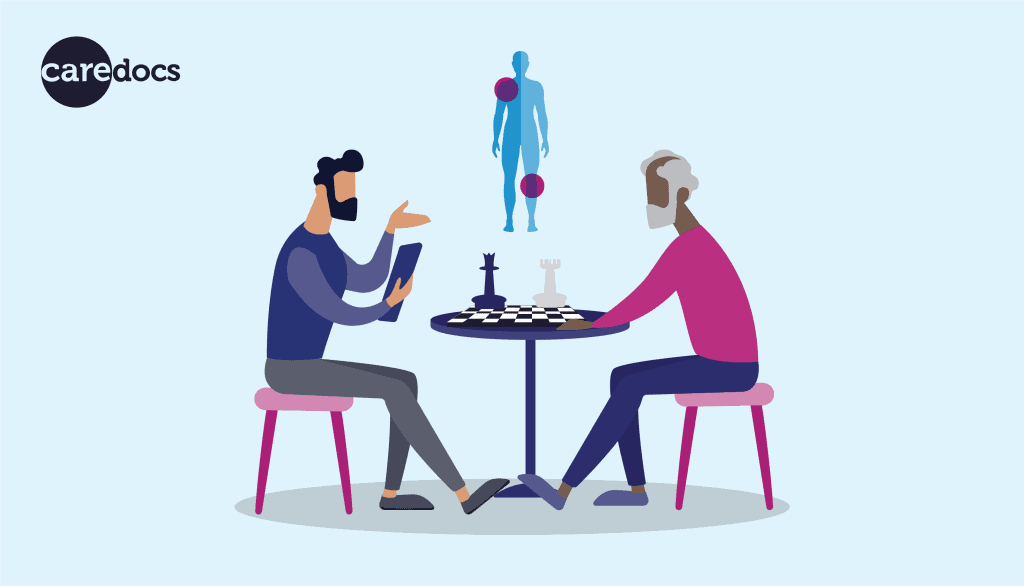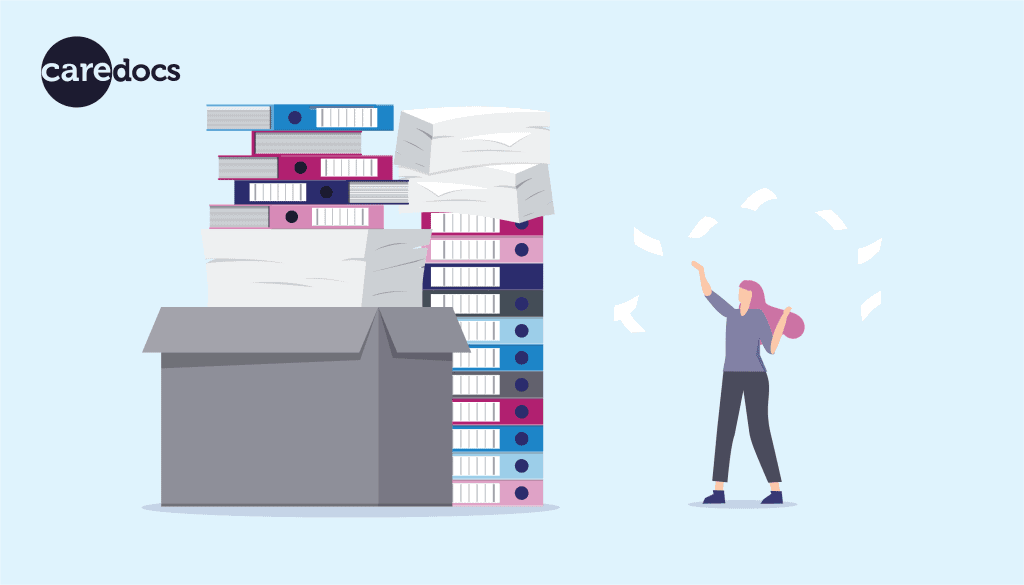Introduction to body maps
- Categories: Best Practice & Advice, Ebooks
Joe Webber
Share this article
Download your free ebook!
Don’t forget to grab your copy of our free Introduction to Body Maps ebook…

Introduction
Body maps have been used in large medical studies for decades and have provided scientific communities with life-saving, easy-to-digest data. Doctors, nurses, carers, physiotherapists, fitness instructors, counsellors, teachers, and many other professionals now use body maps for different purposes. They have become popular tools in hospital and nursing settings due to the benefits for care providers and the residents, but there’s potential for body maps to be utilised more in smaller care environments. This ebook covers the basics of body mapping in care, including the benefits, how they are used, the role technology can play and top tips.
What are body maps?
A body map is a type of chart and a visual tool used mainly in the health sector to accurately record and monitor a range of health conditions. By using a generic image of a body that loosely represents its target audience – for example, a male or female adult or child – you can pinpoint and mark exactly where the individual is experiencing a health related condition or is undergoing treatment. This practice is also referred to as body mapping.
There are several styles of body map charts. The standard and most common chart portrays the human body’s external layer (the skin), which is also useful for making a reference to the size or colour of physically apparent conditions. However, it can be used for the majority of health problems, even those which can’t be seen such as infections and illnesses. Other body map designs can be used to place more emphasis on other layers of the human body, including internal organs, muscles, nerves and the skeleton.

What are the benefits of body maps?
Charting health conditions and their related events on body maps can paint a clearer picture of the resident’s recovery process as a whole. Text notes play a valuable role and should still be recorded to support body maps, but a chart can offer many benefits that you wouldn’t otherwise receive. It can sometimes be difficult to communicate the exact problem using only words, so a well-produced body map can be an easy-to-use resource that displays where on the body the condition is present. In addition to the visual aid, you can document the time the condition was identified, its location, recommended treatment and healing process all in one space. This helps other staff to have a more accurate portrayal of the type of care needed, especially when the issue is internal or hard to see.
Body maps should offer more than just an image – they should tell a story of recovery. Body mapping is most effective when utilised like a journal to record all relevant details so you don’t have to look at multiple documents to find the necessary information. Each time the record is updated, you can add a new chart containing the latest condition details, and by the end of the treatment you will be able to demonstrate how you reached the end result.
Because a wide range of information can be added to the chart, body maps are often used instead of care plans to record short-term health conditions and treatment. By establishing an effective plan of care from the outset and monitoring the progress carefully, the treatment can be recorded using a combination of body map charts and daily notes.
Care plans aren’t usually updated frequently enough to effectively monitor temporary health conditions, such as infections or superficial injuries. Body maps can be reviewed and updated multiple times a day if necessary, so residents will receive better quality and consistent care, which can also lead to improved mood and confidence. Care providers can use the charts as additional documents to evidence higher standards of person-centred care which will support compliance.
How can body maps be used?
Body maps have multiple purposes. They are most commonly used for recording and evidencing resident health conditions and the treatment being provided. But charts can be created as additional supporting tools for any situation where greater detail is needed to clarify the exact location of health conditions or to track injection sites. If you care for people with mental health conditions or mobility issues, body maps can be used to monitor events of self-harm and accidental injuries.
Body map charts are extremely useful for evidencing resident health during the discharge, transfer and admission process between health facilities. Not only can it help the new care provider understand the current status of a resident, but it can highlight potential safeguard risks. The chart can be used to evidence poor care so the appropriate action can be taken.
Another practical use of body mapping is to adopt them as short term care plans for a range of visible and internal conditions. By including a plan of care to support your chart, you can easily monitor the condition and recovery process. This is a more efficient approach to using an individual’s actual care plan to outline treatment, because in many cases the condition will be short-lasting or its status could change frequently, so the care plan will need to be updated continually to stay up to date which is a time-consuming task.
Body mapping can be applied to almost any scenario which involves a physical condition. Here are some of those ways:
- Pain, bruises, injuries, trauma and wounds
- Burns, scalds, rashes and irritation
- Applying topical applications
- Muscle swelling, strains and sprains
- Infections and acute illnesses
- Injection sites and vaccination tracking
- Pressure ulcers and moisture lesions

Paper body maps vs digital body maps
There are two ways body mapping can be incorporated into your workplace. Traditionally, body map charts are completed on paper. A standard blank template can be printed or copied, allowing you to draw and write the condition details by hand. The body map is usually then placed in the resident’s care file and monitored regularly, with new body maps being drawn up with each new update. It’s up to the care provider to source suitable blank body map chart templates to be used throughout the business, which can be bought or downloaded for free on the internet. Body maps generally don’t use much ink to print but storing them away can add to already cumbersome files.
Digital body mapping has become a more popular and practical choice in recent years. Care software and care management systems have allowed many care providers to access body maps on computers and mobile devices. Instead of using a pen and paper, you can click on the image to place a precise marker and type in the supporting information regarding the condition and treatment. The chart is then saved directly to the system you’re using, which eliminates the need to print and physically store it away. Many quality care management systems now provide body mapping features included as part of the package which integrate automatically with the rest of the resident’s digital file, making it the more efficient option.
How can technology help with body mapping?
Many care software suppliers now offer affordable quality body mapping tools as part of wider applications developed for computers and mobile devices. For example, CareDocs is a digital care planning and management system for residential and nursing care homes which includes a wide range of benefits and features. Body mapping is a one easy-to-use feature which automatically links to the resident’s digital care file and daily notes. This means any body map charts you create are stored instantly on your system and can be quickly accessed again when an update is needed. Every care management system is different so check to see if the one you use, or are considering purchasing, includes body maps.
The main role technology plays in body mapping, as well as the majority of care tasks, is increasing overall efficiency. It does this by reducing the number of steps it takes to get from point A to point B which is largely achieved by eliminating the need to use paper. Everything can be done on-screen, so all of the smaller physical administrative tasks which add up over time, such as printing, sorting paperwork, locating stationery and storing documents in filing cabinets, will no longer apply to your daily workload.
Here are a few more ways CareDocs helps you with body mapping:
When opening a new body map on a digital system, you will normally be given a selection of categories to pick from – i.e. infections or burns. This is a useful reminder of the range of conditions you can adopt body mapping for, in case you hadn’t thought of some. To allow other staff to easily view a condition’s progress, you can add daily notes and photos to a body map chart in only a handful of clicks. It’s 100% digital, so you can add as much detail as you like without worrying about the amount of paper you’ll need to organise and carry. However, you have the option to print out a body map to carry with you should you need to.
Care management systems are great at reminding you about updating documents and charts. You can easily place a monitor to automatically notify you in advance when an update is due. To update a body map, you can select the existing chart and simply type in the newest information to evidence all its progress in one place. Because everything is saved on a single system, stored records, no matter how old they are, can be accessed easily by using a range of search functions.

Body mapping tips
Body maps can be created for a variety of purposes so there isn’t one set way to use them. If a condition is marked accurately then you are using the chart correctly. Any additional details you include are a bonus and will support you and the resident throughout the recovery process. The more documentation you compile will also become evidence of the levels of care being provided. But there are several things you can do to ensure your body maps are effective. Here’s our top tips for getting the most out of your body map charts in a care setting.
- For acute illnesses and wounds that can potentially be healed in a short space of time, consider using body map charts to record treatment in place of creating new care plans. Injuries, infections, burns, general pain and other temporary health problems can be treated relatively quickly and body map charts can be updated to evidence every stage of the recovery process. Care plan documents, on the other hand, take longer to read through and are generally not reviewed frequently.
- As well as including a written description of the condition on the chart, ensure you enter a plan of care to verify what action is being taken to support the healing process. This will help support other care staff so the care is consistent and effective. Remember to date the chart and note who created it in case anyone has any questions.
- Be as precise as possible when marking on the body map and set a reminder to review the condition as often as needed. If there’s a visible condition that needs monitoring, such as a burn or wound, make note of the colour and measurement each time so you can compare healing progress. When it’s time to update the body map information, don’t overwrite old information because you will lose evidence of past care.
- Create a new body map chart for each separate condition. You will need to write specific details on the plan of care and having multiple items on one chart can be confusing.
- Log daily notes when creating and updating body maps so other staff members become aware that they exist and must be used.
- You can journal the body mapping process by adding more details each time the condition is monitored. When the condition has been resolved, the ‘journal’ can be archived and used to demonstrate evidence of person-centred care.
To learn more about CareDocs and the benefits and features we offer, please book a free demo with one of our friendly Business Development Managers, email sales@caredocs.co.uk or call 0330 056 3333 (opt. 2).
If you require assistance with the CareDocs software, we’re standing by to provide support. Email support@caredocs.co.uk or call us on 0330 056 3333 (opt. 1).
Download your free ebook!
Don’t forget to grab your copy of our free Introduction to Body Maps ebook…
Share this article
Author
Joe Webber
Search
Recent articles
- CareDocs Partners with the Professional Record Standards Body (PRSB) to Support Care Standards Fit for the Future of Digital Care January 30, 2024
- CareDocs Joins the Care Software Providers Association (CASPA), an Independent, Not for Profit Association, Representing Software in the Care Industry January 19, 2024
- CareDocs partners with Bristol Waste to tackle digital poverty January 10, 2024
Recent comments
- 1.2. Assess use of care plans in applying person-centered values - CIPD Writers on What is person centred care planning and why is it important?
- Call tracking tips for care home marketers - Chester Times on The importance of effective communication in care
- Why is effective communication important for positive relationships with individuals in care? - Building-Craft on The importance of effective communication in care










